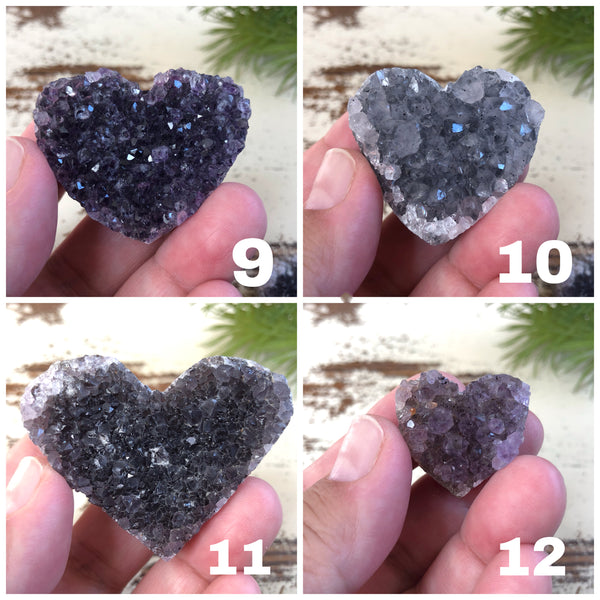Amethyst Cluster Heart
U.S. first class shipping ($3) is already added to price
Gorgeous Amethyst cluster heart. Carefully select the number you’d like. You will receive that exact piece. Prices vary.
From Crystal Vaults.com:
“Purple Amethyst has been highly esteemed throughout the ages for its stunning beauty and legendary powers to stimulate, and soothe, the mind and emotions. It is a semi-precious stone in today’s classifications, but to the ancients it was a “Gem of Fire,” a Precious Stone worth, at times in history, as much as a Diamond. It has always been associated with February, the month the Romans dedicated to Neptune, their water-god, and is the traditional birthstone of that month. It is the stone of St. Valentine and faithful love, and signifies ecclesiastical dignity as the Bishop’s Stone. It carries the energy of fire and passion, creativity and spirituality, yet bears the logic of temperance and sobriety. [Fernie, 170-171][Mella, 73][Eason, 212]
Whether its crystals are left natural, polished as tumblestones, or faceted into magnificent jewels, Amethyst is a gem whose beauty transcends its commonality. It is a variety of Quartz found in many locations around the world, and forms as transparent, terminated crystals of all sizes in geodes, clusters and as long single terminations. It is also found in vitreous masses and polished into wonderful specimens and personal talismans. The presence of manganese in clear Quartz produces Amethyst, while additional amounts of iron vary the purple coloration. Amethyst ranges in hue from pale red-violet to deep violet, and may be transparent or opaque. It is sometimes layered with white Quartz as Chevron Amethyst, found in combination with Cacoxenite, mixed with Citrine as Ametrine, or in rare cases, “rutilated” with Goethite. (See paragraphs below.) [Melody, 109][Hall, 53]
The name Amethyst derives from the Greek word ametusthos, meaning “not intoxicated,” and comes from an ancient legend. The wine god Bacchus, angry over an insult and determined to avenge himself decreed the first person he should meet would be devoured by his tigers. The unfortunate mortal happened to be a beautiful maiden named Amethyst on her way to worship at the shrine of Diana. As the ferocious beasts sprang, she sought the protection of the goddess and was saved by being turned into a clear, white crystal. Bacchus, regretting his cruelty, poured the juice of his grapes over the stone as an offering, giving the gem its lovely purple hue. [Megemont, 24][Kunz, 58-59][Simmons, 28] (See the Legends and Lore section for an alternate version.)
Throughout history the special virtue of Amethyst has been that of preventing drunkenness and overindulgence. Ancient Greeks and Romans routinely studded their goblets with Amethyst believing wine drunk from an Amethyst cup was powerless to intoxicate, and a stone worn on the body, especially at the navel, had a sobering effect, not only for inebriation but in over-zealousness in passion. Catholic bishops also wore Amethyst in a ring to protect from mystical intoxication. Kissing the ring kept others from similar mystical intoxication and kept them grounded in spiritual thought. [Fernie, 169-170][Kunz, 58][Mella, 73][Megemont, 24-25]
Amethyst was also reputed to control evil thoughts, increase intelligence and render men shrewd in business matters. For travelers it was worn as a protection from treachery and surprise attacks, kept soldiers from harm and gave them victory over their enemies. It lent assistance to hunters in the capture of wild beasts and fowl, and was considered to be a powerful psychic stone of protection against witchcraft and black magic. Like other royal stones it protected its wearer from disease and contagion. [Kunz, 58][Fernie, 170][Mella, 72-73]
In the spiritual world, Amethyst provided a connection to the Divine. To the Hebrews, it was Ahlamah, the ninth stone in the breastplate of the High Priest, engraved with the tribe of Dan, as well as the twelfth foundation stone for the New Jerusalem. To the Egyptians, it was Hemag, listed in the Book of the Dead to be carved into heart-shaped amulets for burial. In Eastern cultures, it was listed in descriptions of sacred “gem-cities,” “trees of life,” and used in temple offerings for worship, and to align planetary and astrological influences. It was popular in rosaries and prayer beads, credited with creating an atmosphere of pious calm, imbuing a sense of mental peace and quietude. [Kunz, 236-243, 297, 302-202][Fernie, 169]
In today’s world, Amethyst is still a remarkable stone of spirituality and contentment, known for its metaphysical abilities to still the mind and inspire an enhanced meditative state. Its inherent high frequency purifies the aura of any negative energy or attachments, and creates a protective shield of Light around the body, allowing one to remain clear and centered while opening to spiritual direction. Amethyst stimulates the Third Eye, Crown and Etheric Chakras enhancing cognitive perception as well as accelerating the development of intuitive and psychic ability. It initiates wisdom and greater understanding, and is a stone of comfort for those grieving the loss of a loved one. [Melody, 109][Simmons, 28][Ahsian, 29][Raphaell, 80]
Amethyst’s ability to expand the higher mind also enhances one’s creativity and passion. It strengthens the imagination and intuition, and refines the thinking processes. It helps in the assimilation of new ideas, putting thought into action, and brings projects to fruition. It is a talisman of focus and success. [Megemont, 25]”










